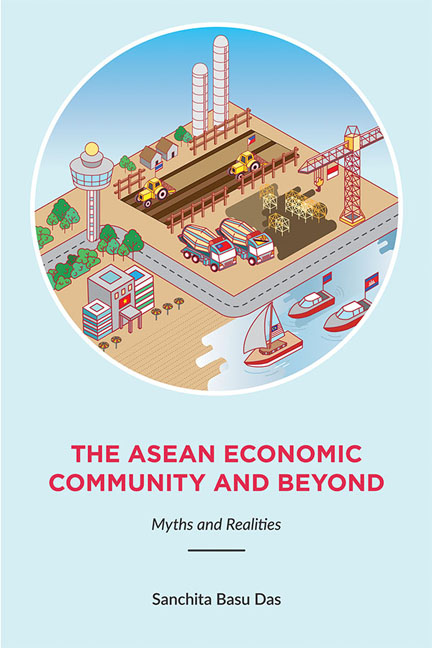Book contents
- Frontmatter
- Dedication
- Contents
- Foreword
- Acknowledgements
- Abbreviations
- 1 Introduction: The ASEAN Economic Community and Beyond
- I THE ASEAN ECONOMIC COMMUNITY (AEC)
- II BEYOND THE ASEAN ECONOMIC COMMUNITY
- 9 The Regional Comprehensive Economic Partnership: Going Beyond ASEAN+1 FTAs
- 10 Comparing ASEAN+1 FTAs for an Effective RCEP
- 11 Challenges in Negotiating the Regional Comprehensive Economic Partnership Agreement
- 12 The Next Decade in ASEAN-U.S. Economic Relations
- 13 RCEP and TPP: Comparisons and Concerns
- 14 The Trans-Pacific Partnership (TPP): Economic and Strategic Implications for the Asia-Pacific
- 15 The Trans-Pacific Partnership as a Tool to Contain China: Myth or Reality?
- 16 RCEP and TPP: Can They Converge into an FTAAP?
- 17 Is APEC's Relevance Fading?
- III AN ASEAN PERSPECTIVE OF REGIONAL CONNECTIVITY
- Appendix: Summary of the Trans-pacific Partnership Agreement
- Index
- About the Author
13 - RCEP and TPP: Comparisons and Concerns
from II - BEYOND THE ASEAN ECONOMIC COMMUNITY
Published online by Cambridge University Press: 19 May 2017
- Frontmatter
- Dedication
- Contents
- Foreword
- Acknowledgements
- Abbreviations
- 1 Introduction: The ASEAN Economic Community and Beyond
- I THE ASEAN ECONOMIC COMMUNITY (AEC)
- II BEYOND THE ASEAN ECONOMIC COMMUNITY
- 9 The Regional Comprehensive Economic Partnership: Going Beyond ASEAN+1 FTAs
- 10 Comparing ASEAN+1 FTAs for an Effective RCEP
- 11 Challenges in Negotiating the Regional Comprehensive Economic Partnership Agreement
- 12 The Next Decade in ASEAN-U.S. Economic Relations
- 13 RCEP and TPP: Comparisons and Concerns
- 14 The Trans-Pacific Partnership (TPP): Economic and Strategic Implications for the Asia-Pacific
- 15 The Trans-Pacific Partnership as a Tool to Contain China: Myth or Reality?
- 16 RCEP and TPP: Can They Converge into an FTAAP?
- 17 Is APEC's Relevance Fading?
- III AN ASEAN PERSPECTIVE OF REGIONAL CONNECTIVITY
- Appendix: Summary of the Trans-pacific Partnership Agreement
- Index
- About the Author
Summary
Asia is witnessing two different approaches to trade liberalization — the Regional Comprehensive Economic Partnership (RCEP) driven by ASEAN and the Trans-Pacific Partnership (TPP) led by the United States. Both TPP and RCEP have quite similar objectives of trade liberalization and economic integration. While tariff rates have been lowered for most of the participating countries, RCEP and TPP are expected to pay more attention to “behind the border” issues or trade facilitation measures, as well as to promote domestic reforms in line with regional goals. But there are differences too. RCEP is said to be accommodative to the development differences of the member countries. TPP, promoted as a “Gold-standard FTA”, is said to have more demanding set of commitments — intellectual property rights, labour standards, competition policy, investment rules, the environment and the role of state-owned enterprises. There are some concerns over competition between TPP and RCEP as regional pacts, which may lead to division among ASEAN members and may undermine ASEAN's centrality in the region. Moreover, as China is not a part of TPP, there is a possibility of conflict due to the rivalry between the United States and China. Nevertheless, both RCEP and TPP are ambitious regional trade arrangements. While, initially they may generate some competition for each other, eventually both are possible pathways for a free trade area of the Asia-Pacific (FTAAP).
INTRODUCTION
As reaffirmed in a 2008 report from the Asian Development Bank (ADB), “Asia's economies are increasingly vital to each other and to the world. Asia's output today roughly equals that of Europe or North America, and may well be 50 per cent larger than theirs by 2020, in terms of purchasing power parity.” Moreover, with both the United States and Europe continuing to post a low GDP growth of 1–2.5 per cent annually, the centre of the recovery has decisively shifted to Asia.
These factors became very apparent during the November 2012 ASEAN summit, when two different approaches to trade liberalization became clear. One is the ASEAN-led Regional Comprehensive Economic Partnership (RCEP) and the other is the U.S.-led Trans-Pacific Partnership (TPP). It was also decided during the meetings that the United States will be able to build its trade relationship with ASEAN through the Expanded Economic Engagement (E3) initiative.
- Type
- Chapter
- Information
- The ASEAN Economic Community and BeyondMyths and Realities, pp. 139 - 149Publisher: ISEAS–Yusof Ishak InstitutePrint publication year: 2015

